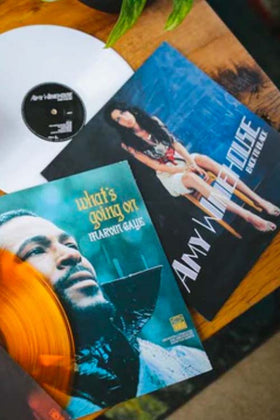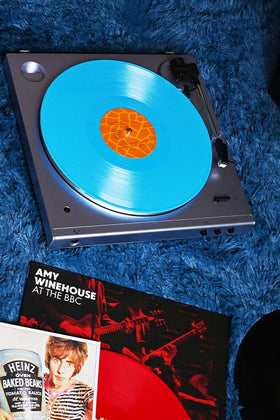Everything You Should Know About Vinyl Record Sizes

There are three main types of vinyl records that you’ll run into as you embark on your vinyl collecting journey. There are the 7-inch, the 10-inch, and the 12-inch. In this post, we’ll uncover everything you need to know about each of these vinyl varieties.
7-Inch Records
These are the smallest vinyl records on the market, and they’ve been around since the early days of the format. Playing at 45 RPM, these records are designed to hold one song on each side. Due to their limited capacity, 7-inch vinyl has historically been used for promotional singles, which were often sold in advance of a full-length LP.
Facts About the 7-Inch
A 7-inch record is often referred to as a “45” due to its RPM. The higher speed and small size mean minimal storage for recorded sound, but these records still have a special place in many collectors’ hearts.
7-inch promotional singles typically feature a highlight track on side A, which is marketed as the main focus of the record. Side B often contains a second, less marketable song which is affectionately referred to as a “B-Side.”
While they were once some of the most commonly found records out there, 7-inches have mostly faded into obscurity since the dawn of the LP. However, some artists still release them as pieces of unique promotional material.
10-Inch Records
10-inch records were originally not made out of vinyl at all – instead, they were hard shellac discs. These early records played at 78 RPM and are often referred to simply as “78s.” They used to be all the rage, but most modern record players don’t support these discs anymore, and they’re more of a piece of vinyl history.
Facts About the 10-Inch
78s have the highest speed of any vinyl record in history. This high speed gives them the potential for unparalleled sound quality – the faster a record spins, the more accurately it can recreate a recording. However, the potential of the 78 for great sound has historically been mostly untapped. The high speeds mean only a few minutes of music can be stored per side on these records, which makes them inaccessible to the modern vinyl listener.
For the most part, 78s faded into the background by the 50s when they were overtaken by LPs.
Are 10-Inch Records Rare?
Since 10-inch records have mostly been rendered obsolete as the decades have passed, it’s easy to wonder whether yours might be worth some money. As you can imagine, the answer depends on the record, its condition, and how many copies were pressed.
Some 10-inch records are incredibly rare, with audiophiles and vinyl enthusiasts sometimes shelling out hundreds of dollars for rare pressings. Others, however, can be found selling for around a quarter at your local Goodwill.
12-Inch Records
Better known as LPs, 12-inch records are the largest form of vinyl on the market. They can hold just over 20 minutes of recorded music on each side, giving them the potential to be used for full-length albums. Their much larger storage capacity comes thanks to their size, as well as their comparatively low RPM – 33 ⅓.
Facts About the 12-Inch
With the LP came the rise of the modern album, which changed the music industry forever. Thanks to LPs, artists had a chance to share a lot more music with potential fans. Even as new audio formats hit the market, the LP kept on going strong, and it’s still one of the most popular ways to listen to full-length albums.
In the early days of the LP, a full-length release was often supported by a 7-inch single or two. In addition, artists would typically push to have their most marketable track, the “lead single,” circulated on the airwaves. Back in the day, long before the age of digital streaming, an artist’s success depended mainly on records, radio, and touring.
I Found a Cool Record. Can My Turntable Play It?
One of the most enjoyable and rewarding parts of the record collector’s journey is digging through bins at thrift stores in search of a hidden gem. With enough patience and diligence, you’re bound to find plenty of pre-owned vinyl to add to your collection – and often at a steal of a price!
However, shopping for used records has a couple of big pitfalls. One of the major considerations to keep in mind when buying used records is that your turntable might not support all of the vinyl that you find at your local thrift store. That’s because many modern turntables are designed to run 33 ⅓ RPM LPs, not 45s or 78s. These smaller records can only run on turntables with adjustable speed settings.
Not sure whether your turntable can play smaller records? When in doubt, check the internet or your owner’s manual!
Caring for Your Record Collection
Now that you know about the different sizes and speeds, let’s quickly cover maintaining and caring for your growing vinyl library.
The more records you collect, the more time you’ll be investing into organizing, storing, cleaning, and, of course, listening. All things vinyl can be enjoyable, but cleaning and maintaining your records is one aspect of collecting that can feel like a bit of a chore. Nevertheless, the better you care for your records, the longer they’ll last – including old vinyl like 78s and 45s.
Restoring Old Records
If you’ve found yourself with some 7-inch or 10-inch records, chances are you might have some work on your hands before they’re ready to spin on your turntable. Old 45s and 78s have typically undergone decades of wear and tear, and some can’t be played at all. However, with some hard work and diligence, you can buff out small scratches, wipe off years’ worth of dust, and get your old vinyl collection back to its former glory.
Taking care of old records starts with examining their condition. Keep an eye out for large scratches, cracks, or signs of warping. If you’re dealing with this level of damage, it’s probably best to abandon ship on your restoration efforts. While a professional can sometimes get a warped or scratched record to sound good again, some records are simply broken beyond repair.
However, if your old record only has minor flaws, you can typically get it back in shape on your own. DIY fixes for scratched records abound, with some of the most popular involving toothpicks and wood glue. If you want to get rid of some smaller scratches, check out this tutorial for a step-by-step guide.
Storing Records of All Shapes and Sizes
Storing your records the right way helps to ensure that they’ll last as long as possible. Some of the basic principles of good record storage include:
- Lining records up like books, not stacking them
- Making sure a row of records isn’t leaning, which can cause some to bear the weight of the others
- Keeping your records in a temperature-controlled space to prevent warping
- Using protective sleeves to protect each record from dust and dings
- Separating records by size, both for easy location and to prevent damage.
Since 78s and 45s are the lightest, smallest records in your collection, these should be kept separate from the larger, heavier LPs. As your collection grows, you might find yourself needing a dedicated shelf for each of these types of records. Some collectors have entire rooms set aside for storing their massive collections!
Want to Learn More About Vinyl Collecting?
You’ve come to the right place. Check out The Sound of Vinyl Blog for more tips on record collecting and maintenance, as well as helpful articles about all things vinyl.
Sources:
B-sides that became more famous than the A-Sides | Radlox
The history of 78 RPM recordings | Yale University Library




